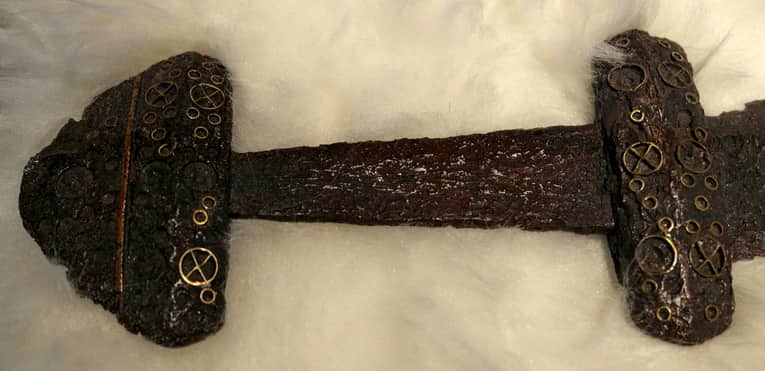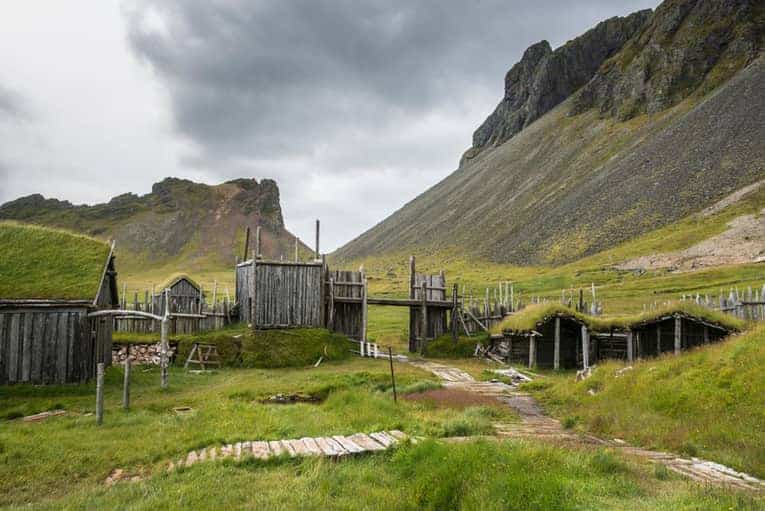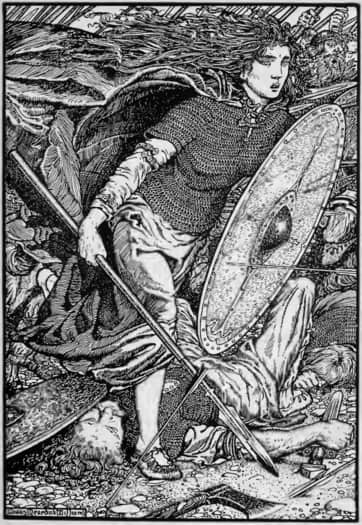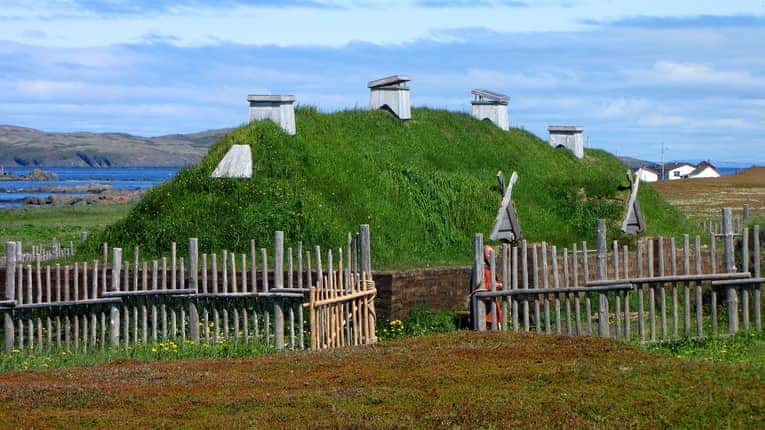The story of the Vikings has fascinated people around the world for nearly 1,000 years. Yet sometimes it can be difficult to separate fact from fiction.
The Vikings were brilliant shipbuilders, ruthless fighters, successful farmers, and faithful to Norse gods.
In the 9th century A.D., the Norsemen exploded out of Scandinavia in Northern Europe, to wreak havoc on their southern neighbors. For three centuries, they explored, plundered, and thrived.
There was a time in the Middle Ages that Western Europe experienced relative peace and security. Threats from the south were non-existent.
Geography hindered threats from the east. Threats from the west, via the other side of the Atlantic Ocean, were centuries away.
However, unknown to many modern-day England, France, and Germany residents, a new threat was developing in the remote north—the Vikings.
Keep reading to learn more.
The Vikings Have a Fascinating History in Scandinavia. See Why did the Vikings Leave Scandinavia? to learn more.

1. Why are they called “Vikings?”
The so-called “Vikings” were Scandinavian people who loved in modern-day Norway, Denmark, and Sweden, as well as other places in Northern Europe. But how did they get the name “Viking” and what does it mean?
The word “viking,” whose etymology (i.e. word history) is rooted in Old English and Old Norse, comes from the noun “vikingr” and the verb “i biking.”
The meaning of the word is “plunderer” when used as a noun and “plundering” when used as a verb. The name refers to raiding, an act for which the Vikings were notoriously known.
The broader meaning of the word “viking,” in some contexts, can refer to someone who plunders at sea, like a pirate. The prefix “vik” in Old Norse often refers to fjords, creeks, and similar waterways. [1]
2. What did the Vikings look like?
To many people, the stereotypical image of a Viking includes people with pale skin and long hair, perhaps blonde.
The Viking in one’s imagination may be wearing a horned helmet, have a sword sheathed at his waist, and have on ragged and dirty clothes.
But is this what Vikings looked like?
Historical evidence reveals that Vikings had pale skin, though there were some darker-skinned Norsemen.
Some had long hair, and their chances of having blonde hair increased if they were from Northern Scandinavia.
Vikings were taller than average European men in the Middle Ages, yet they were about the same height as an average European man today.
Wealthier Vikings owned swords, but many more carried small axes and knives. The Vikings were not all warriors, and those who were did not fight all the time.
Many were farmers, suggesting that some had strong muscles, perhaps weathered skin, as well as stained, calloused hands. Generally speaking, Vikings were not, however, an unkempt people.
The story of the Vikings is fascinating. See A History of the Vikings: A Simple Guide to learn more.

3. How did the Vikings live?
The ancient Norsemen weren’t always sailing ships and sword-fighting enemies. So what was life like for them, especially during times of peace?
Besides doing what they are most known for — raiding and exploring — what were their lives like? (Also see Did the Vikings Have Cats?)
Most of the time, Scandinavians during the Viking age lived in small villages and farmed the land that surrounded them. They raised crops like cabbage, peas, and oats.
They raised animals like cattle, sheep, and pigs. Viking women managed the house, the children, and helped on the farm.
Most Scandinavians in the Middle Ages were fishermen and hunters. Some were shipbuilders and tool makers. Some women made jewelry.
Many Vikings adhered to the religion of Norse paganism in their beliefs and behavior.
4. What was special about Viking ships and sailing?
Shipbuilding and seafaring are an important part of the Vikings’ legacy.
Historically, Viking ships are referred to in their literature, depicted in their art, and even accompany the dead in their graves below ground. [2] But what was so great about them?
Though Viking battleships could vary in size and exact purpose, generally, they were lightweight, able to conform to the water they were in, resulting in great speed, and were navigated by skilled navigators who could use the sun or stars to guide them.
The Vikings also built cargo ships to haul significant amounts of goods and materials to faraway lands like Iceland and Greenland.
The Vikings even sailed to North America (see Vinland below). Cargo ships were shorter and wider than battleships, had deeper hulls, and were slower in the water.
The Vikings were incredible seafarers. See Vikings in America: The Fact to learn more.
5. What is raiding? Why did the Vikings do it?
Raiding is one of the greatest legacies of the Vikings.
These terror-filled, relentlessly brutal, and disturbingly gruesome acts still haunt the shores of Scandinavia’s southern neighbors.
So what was raiding and why did they do it?
Raids were the Vikings’ fiercely violent, unprovoked attacks, on the often defenseless and unsuspecting coastal towns and villages of their Western European neighbors.
The raiders burned homes, violated women, and targeted churches and monasteries because of the valuable items found in them.
Some medieval scholars argue that Viking raids were consistent with the spirit of the Middle Ages.
After all, through the Crusades, even the Christian church participated in violent assaults on their enemies.
Others suggest that perhaps the English, French, and Irish record-keepers exaggerated the brutality of Norse invaders.
6. What was ancient Scandinavia like before the Vikings?
People lived in Scandinavia for centuries before the Viking Age.
Evidence shows that people had hunted, fished, settled, and died in Northern Europe since well before the time of Christ. So what was Scandinavia like before the Viking era?
People first set foot in Scandinavia at the end of the Ice Age, approximately 8,000 to 10,000 years ago.
The hunter-gatherer era led to farming in the Bronze Age.
The Iron Age, after the time of Christ, saw settlements and eventually fortified strongholds, which evolved into regional kingdoms over time.
There were other significant cultural markers in Scandinavia as well.
- The end of the Ice Age resulted in agricultural advancements
- Exploration and trading produced seafaring technologies
- Regional tensions led to the refinement of weapons forged from natural resources
These developments set the stage for the Viking era.
7. What were Viking women like?
The role of women is important to understanding any historical society.
Ancient Scandinavian culture is no different. Viking women had significance in the home, on the farm, and sometimes in trade and business.
Viking women were known for their strong work ethic at home and on the farm.
While they had virtually no role in public life, Viking men and children depended on their care and provision.
Women made clothes to wear, crafts to use and trade and made business decisions when their husbands were traveling.
Evidence from burial sites suggests Viking women were held in higher honor as they aged.
Based on archaeological comparisons, the status of Viking women increased as the Viking era developed. [3]
Historians agree that their social worth was greater than the public acknowledgment of it.

8. What were Viking towns like?
The Viking era was the first in Scandinavian history to establish towns.
Towns developed as the population grew and as resources increased, leading to the establishment of markets and trading posts.
Political affairs, religious worship, and private business could more easily occur in towns as opposed to rural, isolated settlements.
Early Viking towns appeared in the late 8th and early 9th centuries. They grew mostly on coasts and waterways.
They consisted of dozens of family dwellings that were single-story wood structures, often with small gardens outside them.
Political and religious structures were often the most important places in towns, along with ship docks.
Denmark and southern Norway were the first places in Scandinavia to establish towns.
The populations of some towns may have exceeded 1,000 people at their apex.
Some of the first towns in Scandinavia were eventually abandoned due to diminishing natural resources or flooding problems.
Nevertheless, towns slowly grew bigger throughout Scandinavia in the following centuries.
9. What did the Vikings believe? What was their religion?
Like most people groups in history, the Vikings had beliefs about unseen spiritual realities that influenced life in the physical realm.
Though often referred to as Norse “mythology,” these figures were real to the ancient Scandinavians and often shaped their values, priorities, and desires.
The Vikings were polytheistic in that they believed in multiple gods. Odin and Thor are perhaps the most well-known.
Unlike monotheistic religions, Norse gods had weaknesses, setbacks, and experienced loss.
Scandinavian literature, including sagas and poetry, is the source of a lot of this information. [4]
Stories in Norse paganism commonly recount epic battles against seemingly insurmountable enemies and other-worldly places like Ragnarok.
There is less information about systematic doctrines on various topics, compared to some other religions and belief systems.
10. When did Viking raids start?
At the end of the 8th century, there was relative peace along the shorelines of England. Residents lived on rural farms or in small villages.
Christianity was dominant and churches and monasteries were common.
Congregations commonly had wares made of precious metals, like gold goblets used in the Lord’s Supper to show their commitment to their churches.
The Vikings notoriously sprung into history by attacking coastal communities in England.
They quickly discovered that the English made significant financial investments in places that they valued, like churches and monasteries.
The English mustered a resistance, but the Vikings’ persistence and success made raiding a regular occurrence for centuries.
The Vikings first raided England around 789-790; Ireland around 795; and France around 799. Raids on the coast of the Frankish Empire first occurred 15-20 years later.
Putting obstacles in the waterways sometimes slowed the progression of the Vikings temporarily, but they didn’t end the attacks.
11. What kind of weapons did the Vikings use?
Fighting is a significant part of the Vikings’ historical legacy. Their raids were brutal, even if they weren’t always victorious.
The forces were often fearless, tactical, and overpowering in their execution. The weapons the Vikings forged and used in battle were critical to their success.
Vikings often used double-edged swords in combat.
The intention was to hack and slash as opposed to thrust and stab. Axes, spears, knives, and bows and arrows, were also used in battle.
Defensively, many carried three-foot-wide circular shields; some wore helmets and chain mail. Their combat equipment was often decorated with ornate patterns and designs. (Also see Traditional Viking Art: 7 Styles of the Period)
What set the Vikings apart in battle was partly their weapons, but it was more so how they used them in their overall attack strategy, which was often characterized by speed and surprise.
Some Vikings were buried with their weapons. Others have been found and restored in order to teach people about the time period.
12. Did the Vikings raid as far south as the Mediterranean Sea?
Beyond raiding countries in Europe, like England and Ireland, how for south did the Vikings travel to fight?
Did their seafaring skills even take them to other continents? Were they successful there?
In the second half of the 9th century, Vikings attacked sites in the Mediterranean region, including Spain, Portugal, and Italy.
They targeted Christians and Muslims in these areas with varying degrees of success.
They also traveled to islands in the Mediterranean Sea and to coastal settlements on the northern tip of the African continent.
Over the course of two decades, the Vikings discovered that it was much harder to raid the people groups that surrounded the Mediterranean Sea successfully.
Western European countries were less formidable, partly because they were closer to Scandinavia, so after the 9th century, Viking raids in the Mediterranean region were exceedingly rare.
13. Why were Viking raids on England special?
The Vikings are well-known for their battles in Ireland, present-day Germany, and Spain.
Yet perhaps their most popular conflicts are those they had with the English.
England was wealthy, relatively defenseless, and had numerous vulnerable targets along a seemingly endless coastline.
The Vikings’ assault on England in 865 — by the so-called “Great Heathen Army” — was unique because their objective wasn’t to loot and leave, but to conquer and stay.
York, in Northumbria, was a significant victory for the Vikings as was East Anglia in 869.
England was not set up to offer a collective defense against Viking invaders in the 9th century.
Relatively isolated English kingdoms eventually united and pushed out the Vikings whose forces had weakened due to front-line raiders deciding to settle in conquered areas, rather than traveling to fight at the sites of renewed English attacks aimed at dislodging enemy occupants.
14. What did the Vikings do at York in England?
One of the most fascinating feats of the Vikings in the 9th century was what they accomplished at York.
York was a city in the Kingdom of York, south of Scotland and north of Mercia, Wessex, and East Anglia.
Danish Vikings held power in the city and the kingdom for a few decades.
The Vikings took York unopposed in 866.
They first ruled through an English proxy, but the Vikings’ leader, Halfdan, eventually assumed leadership.
After Halfdan died in 877, other Norsemen succeeded him.
The English leader, King Athelstan, pushed the Vikings out of power in 927.
In the 930s and 940s, leadership at York would change hands multiple times.
The English leader, King Eadred, eventually took control of Northumbria in the 950s.
Though the Vikings had a difficult time stabilizing their power in York, it is nevertheless an achievement to invade 9th-century England and occupy a major city, even if it was only for a time.
There were attempts to cement a partnership with other Vikings to stabilize and maintain power, such as Halfdan tried to do with the Vikings in Ireland, but their efforts ultimately failed.
15. Who was Ragnar Lodbrok?
Ragnar Lodbrok is one of the most famous Vikings in history. He is sometimes depicted as similar to a superhero in modern fiction.
Similarly, he is sometimes depicted as other-worldly in ancient Scandinavian literature as well.
Ragnar Lodbork is known for his fighting prowess and his legendary leadership of the “Great Heathen Army.”
What is known about him comes largely from Icelandic and English literature, because the Vikings didn’t keep their own historical records.
Though a popular figure in works of fiction, not much is known about Lodbrok’s life. [5]
According to sagas, poetry, and myth, Lodbrok had several wives in his life, including Lagertha, Thora Borgarhjort, and Aslaug.
He had well-known sons, including Ivar the Boneless and Bjorn Ironside.
Mythical characteristics surround stories of his death and not much can be known about it with certainty.
16. Did the Vikings succeed in raiding Ireland?
Viking raids in Ireland had similarities to raids elsewhere in Europe, but they were unique as well.
The Norsemen were present in Ireland in some way for most of the 9th century.
They even held control in the East Coast city of Dublin for a time.
The Vikings launched a surprise, unpatterned attacks on the Irish coast in the early 9th century, aiming mostly to loot monasteries.
Their fleets grew as did the frequency of their attacks, which put pressure on fractured Irish defenses.
Victories led to settlements, and settlements led to political control.
When Irish defenses strengthened, the Vikings were pushed out of Dublin and many went to raid elsewhere in Europe.
Vikings returned in large numbers to Ireland about 40 years later in 914.
This time, their raids didn’t become settlements. Formidable Irish defenses and interest in the successes of other Vikings in England, like York, drew many Norsemen from Ireland in the early 10th century.
Some historians mark the year 1014 and the Battle of Clontarf as the end of the Viking age in Ireland.
17. Did the Vikings turn on each other at Francia?
In the 9th century, the Frankish Empire, ruled the present-day land of France, Belgium, The Netherlands, Luxembourg, and Germany.
Charles II, or “Charles the Bald,” King of West Francia, had experienced some setbacks and some victories in his battles with the Vikings. He built fortifications, like protective walls, but vulnerabilities persisted.
Charles had an unusual idea in 860. He offered to pay Weland, a Viking chief, to attack another group of Vikings was positioned on the Seine River. Weland agreed.
Upon learning the news, the Vikings at Seine offered Weland a bribe, which he took, and then they fled.
The next year, those same Vikings returned and launched raids against the Franks.
Charles’ idea was not successful; moreover, the fighting strategies of local bands of fighters had greater success against Viking invaders than he did.
Local successes eventually made a collective difference, resulting in Viking attacks waning.
Externally, Viking success in England drew many away from the Frank Empire.
18. Did the Vikings reach America?
The Vikings’ sailing expertise enabled them to navigate rivers and oceans far away from Scandinavia, like the Mediterranean Sea.
It’s widely known that they sailed west to Iceland and even to Greenland.
But did they ever reach North America and the eastern coast of the United States?
Viking explorers first reached the mainland of North America in the late 10th century.
The first to see land west of Greenland was Bjorn Herjolfsson in 985.
In the year 1000, Leif Eiriksson set out to find the land, which he did and wintered on its coast.
He called it “Vinland,” meaning “Wine Land,” because the grapes he found there were in abundance.
He did not likely travel as far south as the present-day East Coast of the United States.
The precise location of where Eiriksson wintered is debated. Some speculate it was the East Coast of present-day Newfoundland.
Others suggest it was south of the Gulf of Saint Lawrence, north of Cape Cod.
Norse attempts to establish permanent settlements in future years didn’t succeed.

19. Who was The Thunderbolt of the North?
In the 11th century, there was one Viking who began fighting for Norse causes at the age of 15.
After that battle was lost, he fled east to Sweden, then further east to Russia where he became a mercenary.
He then traveled to Constantinople, the hub of the Byzantine Empire, and became a member of the emperor’s elite fighting unit.
He did all this and his career was just getting started. So who as he?
Harald Hardrada — also known as “The Thunderbolt of the North” — was the half-brother of King Olaf Haraldson of Norway.
After about a decade, Hardrada left Byzantium, returned to Sweden, built an army, and invaded Denmark in 1046, which he eventually ruled.
Hardrada’s rule in Denmark was unstable. He recognized Swein Estithson, his nephew, as ruler in 1064 after years of conflict.
Hardrada died in 1066 in England.
He invaded the West Coast, and even took York temporarily, but then died, along with most of his army, five days later.
20. When did the Vikings convert to Christianity?
Studying 9th and 10th-century Viking culture and worldview may lead one to believe that their beliefs and way of life were so deeply, that they would never change.
Yet by the dawn of the 13th century, Norse paganism had been supplanted in most public ways. (Also see Valhalla vs Asgard: What’s the Difference?)
Primary proponents of Christianity included Harald Bluetooth of Denmark, Olaf Tryggvasson and Olaf Haraldsson in Norway, and Olaf Skotkonung in Sweden.
The rise of churches united Scandinavia under a new worldview, unifying their causes and opening the door to stronger relationships with their like-minded European neighbors to the south. Some conversions were nominal; others were authentic.
Though Norse paganism could still be found throughout the region, Scandinavia was Christianized by the late 12th century.
The activities of these nations didn’t change immediately, as raiding was replaced with crusading, which looked similar to the killing and looting that marked their previous way of life.
21. What happened after the Vikings?
The Viking era didn’t end all at once; its end was brought about through a series of internal and external events and circumstances.
Some argue Scandinavia’s transformation was inevitable because the Viking way of life was not sustainable.
Others argue a new way of life was impressed upon them by means of a new worldview that oppressed the old one.
Christianity displaced the Viking era, first by means of worldview, and second, by means of new behaviors, which led to new relationships.
Churches, bishops, and the Bible replaced old devotions.
Additionally, rather than raiding themselves, they were instead the targets of raids, especially by Slavic tribes from the east.
Regional conflicts marked the 13th century, yet Scandinavian countries grew nevertheless.
Medieval Latin Christianity characterized the region until the Protestant Reformation.
The Reformation, born in Germany, France, and Switzerland, eventually reached Scandinavia and transformed the region. Still today, Lutheranism dominates the church landscape.
The Viking era came and went, but few people groups have left a mark on the Western world as they did.
They were a people group known largely for their fighting, but there was more to them than that.
They loved the sea, worked their farms and were passionate about their way of life.
References:
[1] Source
[2] Source
[3] Source
[4] Source
[5] Source
